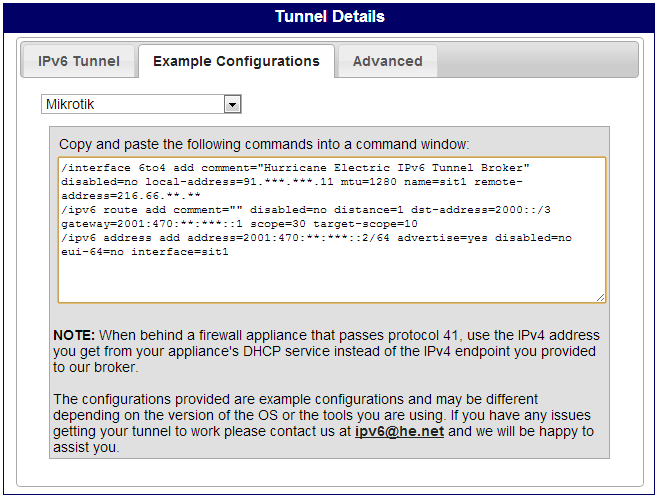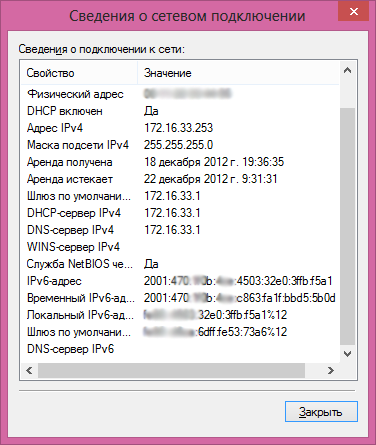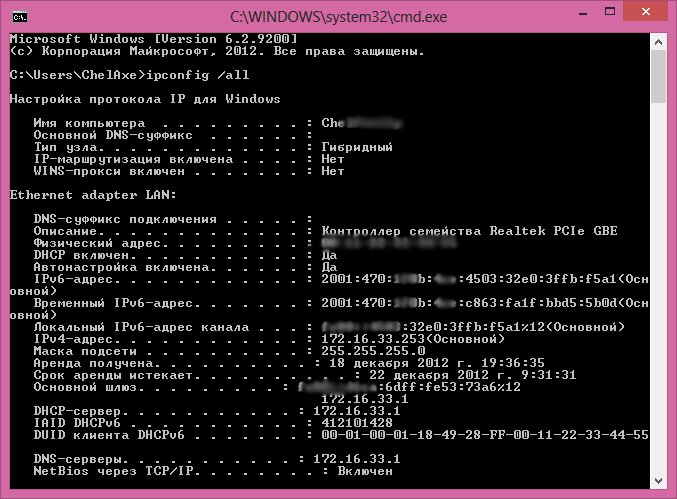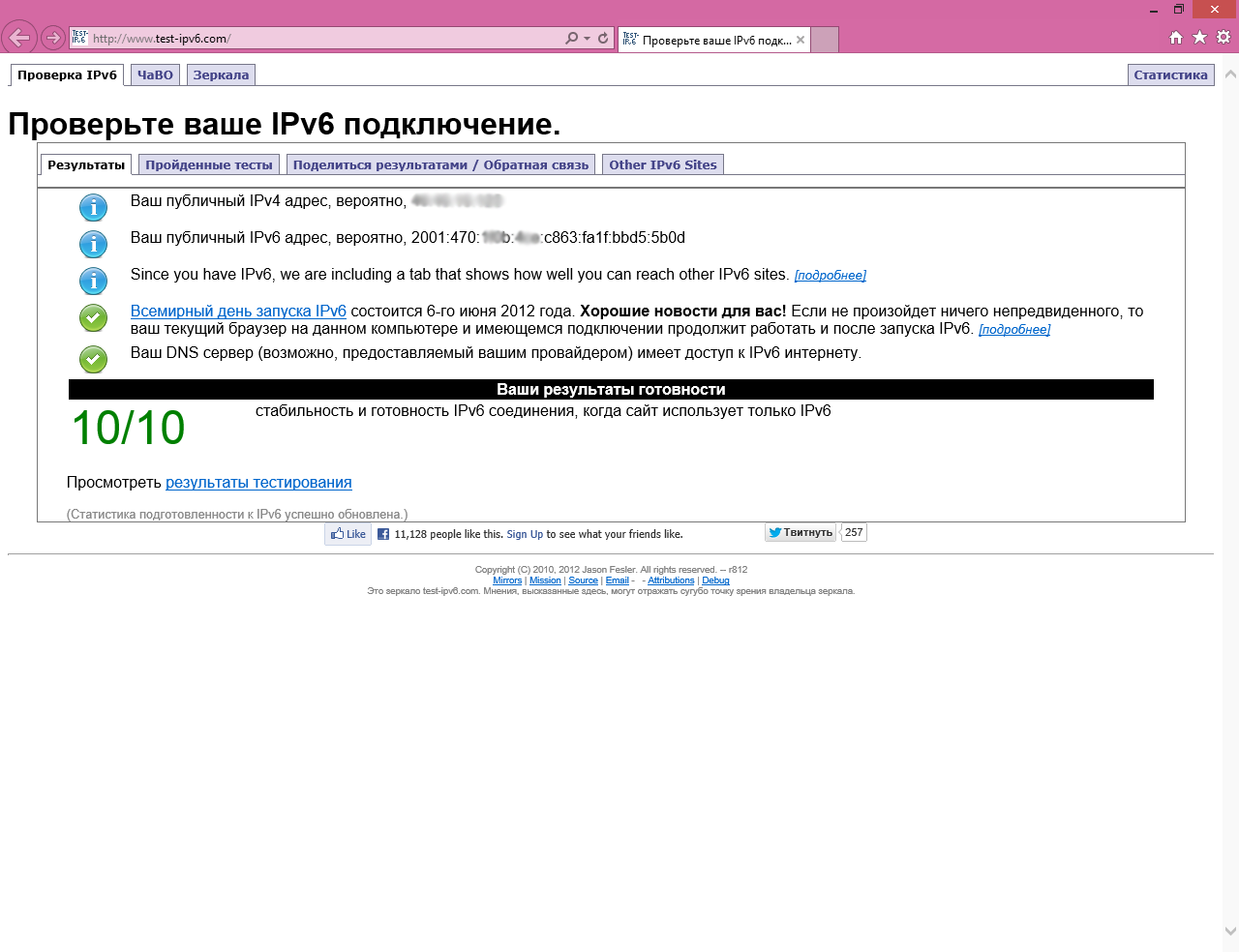MikroTik - 6in4 or IPv6 without provider support
I wanted to use IPv6 technology for some reason , but my provider does not provide this service. Google suggested a 6in4 mechanism that allows me to transfer IPv6 packets through the IPv4 network of my provider, which is supported by my MikroTik RouterBoard 951g-2hnd router .

First we need:
Register with a tunnel broker. I use Hurricane Electric
We go to this address and register. This is nothing complicated. In response, we receive an email with a username and password. We enter them on the website and create a tunnel: “User Functions - Create Regular Tunnel” In the field, enter your dedicated IP address, next to your current IP address, if you register where you want to configure this connection, the highlighted IP address is identical to the current one. Next, select the nearest tunnel server, this can help us: Looking Glass . We create!
As a result, we get:

Here the IPv4 and IPv6 server addresses are indicated, as well as yours - the client. Also below is the / 64 network for your devices.
In the tab“Example Configurations” we select settings for MikroTik:

Let's say your dedicated IP address 49.45.157.133 , server address 236.63.85.135 , IPv6 server address 2001: 470: 2e3a : 5FE :: 1 and the IPv6 address of the client in 2001: 470: 2e3a : 5FE :: 2/64 , as well as in 2001: 470 : 2e3b : 5fe :: 1/64 the first address on the / 64 subnet allocated to you 2001: 470: 2e3b: 5fe :: / 64
Those settings that were offered to us in the Example Configurations section :
And the IPv6 address for the BRIDGE interface: BRIDGE
interface I have integrated internal ethernet ports and a wireless interface, and IPv4 is also distributed on the network.
On your computer, enable IPv6 support if you have it disabled. Internet access over IPv6 should appear. IPv6 addresses should also appear in the interface information or in the console when the ipconfig / all command is displayed
If everything is in order then ipv6.google.com should respond , and also pass the test successfully
If the last part of the test fails and you have 9/10, then your DNS server (provided by your provider) does not have access to IPv6 Internet. It is treated easily just prescribe Google DNS
Windows periodically generates IPv6 addresses, which is why some sites swear that the user changes the IP address. Disconnecting is simple (without rebooting):
When writing, I used:
IPv6 Basics
IPv6 - it's nearby.
IPv6 Protocol

Start
First we need:
- “White” permanent IPv4 address from the provider (the so-called dedicated IP address) - if you have a “white”, but dynamic address, then you should read this: Hurricane Electric IPv6 Tunnel - IPv4 Endpoint updater
- incoming ICMP packets are not blocked (i.e. your dedicated IP address can be pinged from the Internet. Some providers block incoming ICMP packets)
Tunnel broker
Register with a tunnel broker. I use Hurricane Electric
We go to this address and register. This is nothing complicated. In response, we receive an email with a username and password. We enter them on the website and create a tunnel: “User Functions - Create Regular Tunnel” In the field, enter your dedicated IP address, next to your current IP address, if you register where you want to configure this connection, the highlighted IP address is identical to the current one. Next, select the nearest tunnel server, this can help us: Looking Glass . We create!
As a result, we get:

Here the IPv4 and IPv6 server addresses are indicated, as well as yours - the client. Also below is the / 64 network for your devices.
In the tab“Example Configurations” we select settings for MikroTik:

Configure Mikrotik
Let's say your dedicated IP address 49.45.157.133 , server address 236.63.85.135 , IPv6 server address 2001: 470: 2e3a : 5FE :: 1 and the IPv6 address of the client in 2001: 470: 2e3a : 5FE :: 2/64 , as well as in 2001: 470 : 2e3b : 5fe :: 1/64 the first address on the / 64 subnet allocated to you 2001: 470: 2e3b: 5fe :: / 64
Those settings that were offered to us in the Example Configurations section :
/interface 6to4 add comment="Hurricane Electric IPv6 Tunnel Broker" disabled=no local-address=49.45.157.133 mtu=1280 name=sit1 remote-address=236.63.85.135/ipv6 route add disabled=no distance=1 dst-address=2000::/3 gateway=2001:470:2e3a:5fe::1 scope=30 target-scope=10/ipv6 address add address=2001:470:2e3a:5fe::2/64 advertise=yes disabled=no eui-64=no interface=sit1 And the IPv6 address for the BRIDGE interface: BRIDGE
/ipv6 address add address=2001:470:2e3b:5fe::1/64 advertise=yes disabled=no eui-64=no interface=BRIDGEinterface I have integrated internal ethernet ports and a wireless interface, and IPv4 is also distributed on the network.
On your computer, enable IPv6 support if you have it disabled. Internet access over IPv6 should appear. IPv6 addresses should also appear in the interface information or in the console when the ipconfig / all command is displayed
Interface Details

ipconfig / all

If everything is in order then ipv6.google.com should respond , and also pass the test successfully
Ping ipv6.google.com

Test test-ipv6.com

If the last part of the test fails and you have 9/10, then your DNS server (provided by your provider) does not have access to IPv6 Internet. It is treated easily just prescribe Google DNS
Google Public DNS IP addresses
The Google Public DNS IPv6 addresses are as follows:
8.8.8.8
8.8.4.4
The Google Public DNS IPv6 addresses are as follows:
2001: 4860: 4860 :: 8888
2001: 4860: 4860 :: 8844
You can use either number as your primary or secondary DNS server
You can specify both numbers, but do not specify one number as both primary and secondary.
You can configure Google Public DNS addresses for either IPv4 or IPv6 connections, or both.
Windows periodically generates IPv6 addresses, which is why some sites swear that the user changes the IP address. Disconnecting is simple (without rebooting):
netsh interface ipv6 set global randomizeidentifiers=disabled store=active
netsh interface ipv6 set global randomizeidentifiers=disabled store=persistent
netsh interface ipv6 set privacy state=disabled store=active
netsh interface ipv6 set privacy state=disabled store=persistent
When writing, I used:
IPv6 Basics
IPv6 - it's nearby.
IPv6 Protocol
